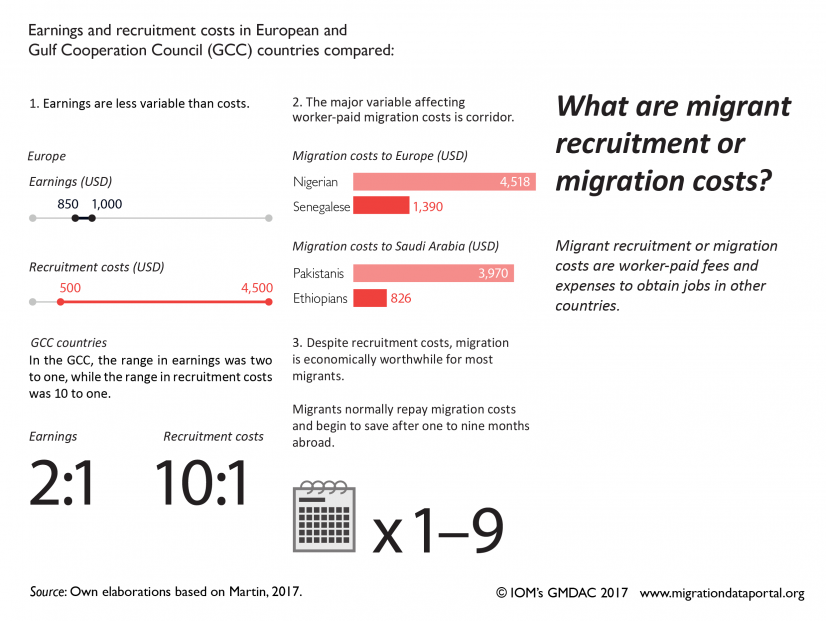Recruitment costs are high, regressive and non-transparent
There are many reports of migrant workers paying high fees and taking on debt at high interest rates to obtain contracts to work in other countries, prompting global efforts to develop a database of worker-paid migration costs and policies to reduce them.
The International Labour Organization (ILO) conventions and the laws of many EU countries require employers to pay all of the costs associated with recruiting foreign workers. Employers usually pay recruitment costs for highly skilled workers, since the demand for mobile professionals such as accountants and nurses typically exceeds the supply of workers willing to move. But the supply of workers earning less than USD 500 a month often exceeds the number of jobs, allowing employers, recruiters and others to charge workers some of the wage gap between poorer and richer countries that motivates workers to seek foreign jobs.
High worker-paid costs are regressive in the sense that lower-wage workers pay more for foreign jobs than higher-wage workers. Furthermore, many workers do not know upfront how much they will have to pay for foreign jobs, so they can be induced to pay more than they expected. This combination of high costs, regressivity and non-transparency prompted the UN Secretary General to emphasize the “enormous gains to be made by lowering costs related to migration […] especially by low-skilled migrant workers.” (2013: para 113).
Recruitment costs differences: Intra-EU vs non-EU workers and high vs. low-skilled migrants
Employers seeking workers and workers seeking jobs incur costs. The major costs incurred by employers are the cost of leaving the job vacant, the cost of advertising and screening applicants, and the cost of training newly hired workers. The major costs of workers include lost earnings while seeking a job, spending money on training or other assistance to increase the chances of being hired, and paying a recruiter to get a contract for a particular job.
No one knows how much employers and EU workers spend to move to other EU Member States for jobs, and there are even fewer data on what non-EU migrant workers spend to get jobs in the EU. There are two major types of migrant workers in EU countries: intra-EU migrants and third-country nationals.
Examples of intra-EU migrant workers are Poles or Portuguese employed in the UK who move under freedom of movement regulations, one of the four pillars of the EU, viz, the free movement of goods, capital, services and labour between EU Member States. Intra-EU migrant workers can find jobs in other EU countries by paying for transportation and seeking work after arrival, or they can find a job in another country before they depart and negotiate with their future employer about sharing the costs of transportation and related expenses.
In many cases, intra-EU migrant workers move as employees of temp or staffing firms that recruit workers in one country and “post” them in another. Temp or agency workers may not pay upfront for jobs in other EU countries, but they often earn lower wages or receive fewer benefits than similar local workers, so payment for their jobs often takes the form of lower earnings.
Third-country or non-EU workers may pay for EU jobs upfront in recruiter fees and after arrival in lower wages and fewer benefits. EU employers of migrant skilled workers such as nurses generally pay recruitment and transport costs, and may provide housing and other benefits. However, employers of lower-skill migrant workers often rely on temp agencies to recruit workers or use network hiring to find additional workers, which involves current employees referring qualified friends and relatives, reducing the need to post ads and screen workers who apply for jobs.
Matching workers with jobs has costs that must be paid by someone, employers, workers, or governments. Workers who invest in education and training and obtain licenses and certificates generally find that employers seek them out and often pay their costs to move to the job. Low-skilled workers, on the other hand, may find that there are 5 or 10 workers seeking each available job, allowing recruiters and other intermediaries to use worker willingness to pay to ration EU jobs.
There is no firm salary ceiling above which employers pay worker recruitment costs. However, workers earning USD 2,000 or more a month are much more likely to have employers pay their recruitment costs than workers earning less than USD 1,000 a month. Workers with higher earnings have often invested in education and training to earn degrees and certificates that reduce their costs when moving over borders for jobs.
Survey data on worker-paid costs for migrants in Italy and Spain
The Global Knowledge Partnership on Migration and Development (KNOMAD) and the ILO surveyed migrant workers to determine what they paid for foreign jobs. Data were collected from workers employed in Italy and Spain, all of whom were young and low skilled, typically between 20 and 35. Most had not completed secondary school.
A 2016 survey in Italy of non-EU workers who arrived by boat and in other irregular ways from Egypt, Ghana, Nigeria and Senegal found median Italian earnings of USD 850 a month (Martin, 2017). There was much more variance in worker-paid migration costs: Egyptians paid a median USD 3,200 or almost four months median Italian earnings; GhanaiansUSD 1,800 or over two months Italian earnings; Nigerians USD 4,500 or over five months Italian earnings; and Senegalese USD 1,400 or almost two months earnings. Many of the migrants reached Italy by boat from Libya, and transportation was an average 60 per cent of migrant-paid costs (Ibid.).
A 2014 survey of migrant workers from Bulgaria, Ecuador, Morocco, Poland and Romania employed in Spanish agriculture found average earnings of USD 1,000 a month (Martin, 2017). Median migration costs were USD 500 or half a month’s wages. Most of the workers were employed in Spain from four to nine months, earning USD 4,000 to USD 9,000 to fill seasonal farm jobs. However, the intra-EU Eastern European migrants had only (bus) travel costs, and employers paid half of the travel costs of the non-EU Moroccans and Ecuadorians. Intra-EU migrants did not have costs for passports, medical checks and recruiter fees (Ibid.).
The major difference between migrants going to Italy and Spain was that the migrants in Spain were recruited by employers, arrived legally and went to work immediately. By contrast, the migrants in Italy arrived in an irregular status and had to find jobs, which meant sometimes lengthy delays as they went through the asylum process.
The Italy and Spain surveys have three major findings. First, migrating legally and having a job waiting reduces migration costs. Second, network recruitment is very important to employers and workers, so that once a core group of reliable workers are in place, the employer asks them to refer friends and relatives who are qualified to do the job. Newly hired workers often train the new hires they bring into the workplace, reducing costs and burdens on employers.
Third, migration is economically worthwhile for low-skilled migrants. Migrants in Spain repaid their migration costs with less than a month’s earnings. Since many were not employed at home, working six months in Spain generated at least USD 5,000 that the worker would not have had at home. Migrants in Italy expected to stay indefinitely, and despite traveling irregularly via Libya, most could repay their migration costs with less than five months of Italian earnings.
Comparison of recruitment costs in the EU vs. GCC countries
How do EU recruitment costs compare with costs to move to Gulf Cooperation Council (GCC) countries where migrant workers are over half of private sector workers? Low-skilled migrants interviewed as they returned from GCC countries in 2015 reported GCC earnings of USD 265 to USD 500 a month and recruitment costs that ranged from USD 400 for Filipinos to USD 4,000 for Pakistanis. Guest workers in the GCC stayed an average of two years, and Filipinos and Indians repaid their migration costs much faster than Pakistanis.
European GCC comparisons of earnings and recruitment costs suggest three major patterns. First, earnings are far less variable than costs. In Europe, the earnings of low-skilled workers were USD 850 to USD 1,000 a month, while recruitment costs ranged from a few hundred dollars to USD 4,500, up to 20 to one. In the GCC, the range in earnings was two to one, while the range in recruitment costs was 10 to one.
Second, the major variable affecting worker-paid migration costs is corridor. There was little difference in migration costs among Nigerians in Italy or Pakistanis in Saudi Arabia by age, education, sex, previous migration experience and other factors that may have been expected to influence what they paid for foreign jobs, but big differences between what Senegalese and Nigerians paid for jobs in Europe, or what Ethiopians and Pakistanis paid for jobs in Saudi Arabia. Policies such as worker education and recruiter transparency can reduce migration costs in all corridors, but corridor-specific policies are likely required to reduce costs in many corridors.
Third, migration is economically worthwhile for most migrants despite paying one or more months of foreign earnings to obtain jobs. Migrants normally repay migration costs and begin to save after one to nine months abroad, which gives them more money than if they had remained jobless or in a low-earning job at home. Migration that delivers a payoff after a few months’ work provides an enormous incentive for young people to move.














